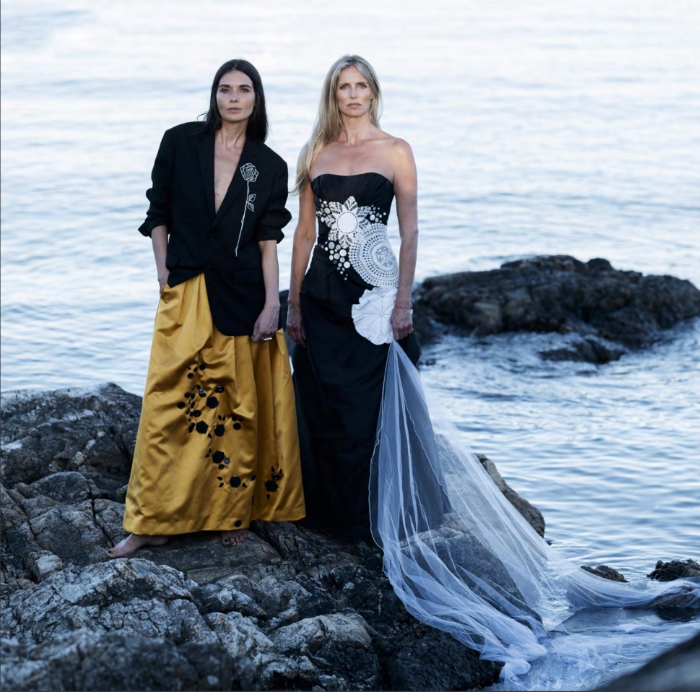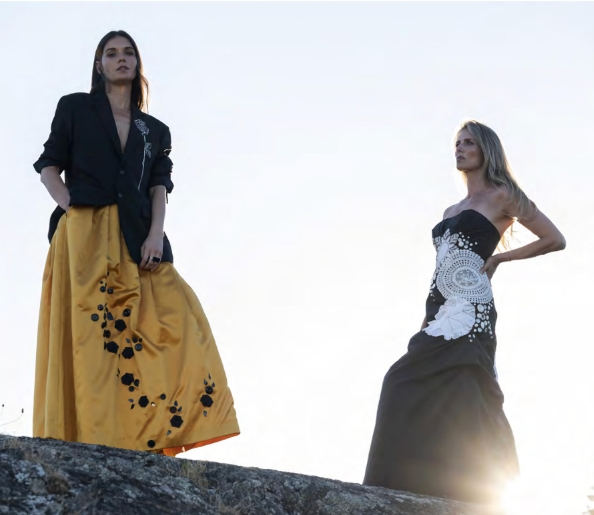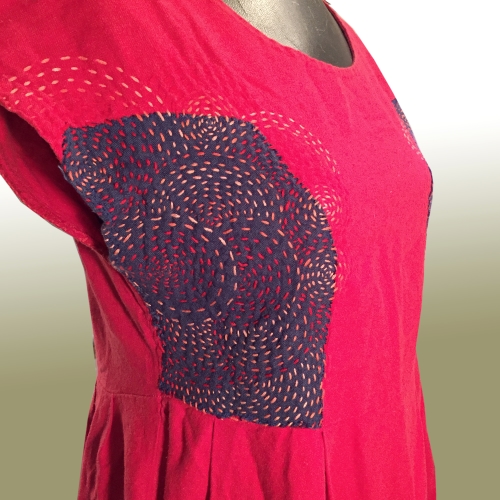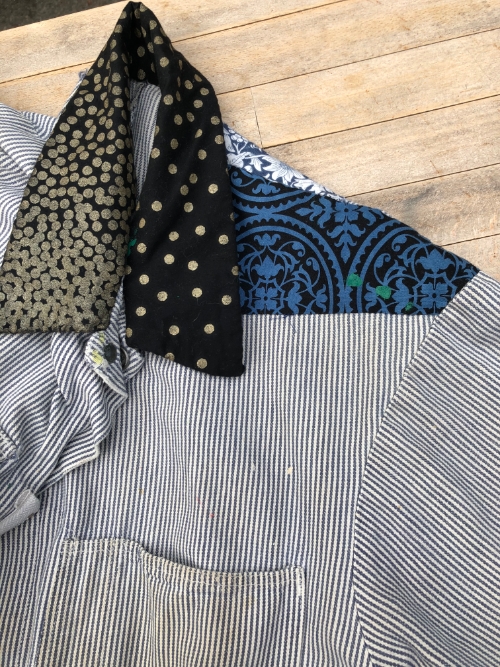UPCYCLE: Repurposing, visibly mending and creating sustainability in the fashion industry
by Laura Goldstein
 When upscale Victoria consignment fashion boutique, House of Savoy filled their storefront window with mounds of used clothing on a recent Earth Day, it wasn’t a ploy for new business. Rather, a not so subtle wake-up call to rethink tossing away clothing that would end up in a landfill. According to a study carried out by the University of Waterloo in 2023, Canadians dump close to a staggering 500 million kilograms (500,000 tons) of fabric clothing and shoes a year, many of which could be repaired, up-cycled or consigned for re-use.
When upscale Victoria consignment fashion boutique, House of Savoy filled their storefront window with mounds of used clothing on a recent Earth Day, it wasn’t a ploy for new business. Rather, a not so subtle wake-up call to rethink tossing away clothing that would end up in a landfill. According to a study carried out by the University of Waterloo in 2023, Canadians dump close to a staggering 500 million kilograms (500,000 tons) of fabric clothing and shoes a year, many of which could be repaired, up-cycled or consigned for re-use.
Buying repurposed clothing actually started after WWI when people had to recycle their clothes due to fabric shortages and necessity. How things have changed! With the advent of slow fashion awareness people are questioning how clothing and textiles are made and their environmental impacts. “ It’s trendy to buy vintage and consignment today but we really saw an increase after Covid,” says House of Savoy co-owner, Émilie Hamel. “ People wanted to make a bit of extra money and didn’t want to spend a lot in many cases, for a work at home lifestyle.”
“And by consigning clothes, it’s kind of like an exchange: bring something in you’re not wearing anymore but you get something in return,” adds co-owner Zenija Esmits. “ And, when searching for vintage and antique pieces people are looking for quality and it’s also an investment.”
Specializing in consignment of vintage and antique clothing, Hamel designates vintage as “pieces over 20 -years -old. However, new ‘fast’ fashion name brands can also be consigned.” Both women are scrupulous researchers of the historical provenance for all their merchandise. “We have a lot of antique pieces like original Chanels from the ‘20s,” Hamel explains. In fact, based upon Hamel’s definition, it might be fair to say that House of Savoy is truly a ‘vintage’ business. As one of the oldest in Canada, it was owned and operated by women since 1978 under the original name, Encore. In 1980, it was purchased by the boutique’s accountant, Marian Savoy. Then in 1993 Anna Hesung Back purchased House of Savoy transforming the interiors into a Parisian atelier. In 2021 Émilie Hamel and Zenija Esmits bought the business, expanding inventory to also include consignment wedding gowns, vintage coats, shoes and sought-after accessories.
 Demographics and social media have also changed fashion dictates for what women and men wear today. “When we were growing up we might have been influenced by a particular trend or celebrity but today, young people also know about the environment and are more concerned about where clothing comes from than our generation,” admits Hamel. “Teens are very into original vintage ‘90s clothing probably made in the U.S. at that time. We’ve had clients as young as 12-years-old coming in with their parents to re-sell on consignment. Teens looking for vintage prom dresses is also very popular. We try to keep prices reasonable and we have a big following of collectors outside of Victoria,” she adds. With the booming film and television industry in B.C., House of Savoy also attracts costumers and scouts for magazine fashion layouts. On yearly buying trips to Paris and London the intrepid pair scour thrift stores, charity shops and outdoor antique markets known as brocantes to discover one-of-a-kind treasures for their clients.
Demographics and social media have also changed fashion dictates for what women and men wear today. “When we were growing up we might have been influenced by a particular trend or celebrity but today, young people also know about the environment and are more concerned about where clothing comes from than our generation,” admits Hamel. “Teens are very into original vintage ‘90s clothing probably made in the U.S. at that time. We’ve had clients as young as 12-years-old coming in with their parents to re-sell on consignment. Teens looking for vintage prom dresses is also very popular. We try to keep prices reasonable and we have a big following of collectors outside of Victoria,” she adds. With the booming film and television industry in B.C., House of Savoy also attracts costumers and scouts for magazine fashion layouts. On yearly buying trips to Paris and London the intrepid pair scour thrift stores, charity shops and outdoor antique markets known as brocantes to discover one-of-a-kind treasures for their clients.
Esmits relates one of those surprising finds: “Albeit slightly worn with possible age marks, a feather confection of a hat came into our shop shortly after taking over in July 2021. When it reached its ‘sell-by’ date and hadn’t sold we had a note from the consignor saying we were able to keep it as display. After visiting the Galleria Dior in Paris this past January, we were interested to find out that Christian Dior is the one and only designer to have an in-house milliner to this day. All other fashion houses outsource the once standard craft. ”
You may remember the hippy ’60s when it was groovy to customize your old jeans and jean jackets with embroidery and colourful patches. The idiom, ‘everything old is new again’ rings true today more than ever with the growing craft of visible mending.
 “Visible mending is a slow fashion art form that has its roots in Japanese sashiko in which colourful embroidery is meant to highlight rips and tears, not cover them up,” explains Amy Walker who teaches workshops in up-cycling clothing with visible mending in Vancouver. Tiny stitches in swirling patterns and contrasting colours emblazon an up-cycled summer dress of Walker’s; her old coverall takes on a new life with the addition of vibrantly patterned patching and holes in socks are treated to painterly multi-hued darning stitches.
“Visible mending is a slow fashion art form that has its roots in Japanese sashiko in which colourful embroidery is meant to highlight rips and tears, not cover them up,” explains Amy Walker who teaches workshops in up-cycling clothing with visible mending in Vancouver. Tiny stitches in swirling patterns and contrasting colours emblazon an up-cycled summer dress of Walker’s; her old coverall takes on a new life with the addition of vibrantly patterned patching and holes in socks are treated to painterly multi-hued darning stitches.
Walker’s Experimending workshop at Vancouver’s Museum of Anthropologie (MOA) attracted over thirty hands-on participants of all ages who brought a previously worn piece of clothing to embellish. The class was followed by discussions on the historical role of visible mending practiced for centuries by mostly women in almost all cultures. “ If you love a piece of clothing but there’s a tear, no need to toss it out – just get creative and personalize it because it tells a story about you.”
Luxury brands and slow fashion sustainability awareness don’t have to be mutually exclusive. However, sustainability does need to start from the top with fashion brands taking responsibility directly for sourcing fabrics and manufacturing their garments that in the long run will remain durable. Senior Apparel & Textile Sustainability Strategist, Maryam Laroche has carved out a niche career for herself as one of Canada’s most passionate supporters of sustainability and repurposing awareness in the fashion industry. The trailblazer was responsible for bringing Eco Fashion Week to Vancouver in 2017 where she lived for 11 years, founding the non profit in 2009. Back in Quebec City she recently launched her new agency, Collective Detour that assists fashion brands in creating more sustainable futures.
“One of the ideas I worked on for national retailer, Simons involved a discussion for a repurposing ‘take-back’ programme, but frankly I think each brand should be responsible for their own product re-cycling with a section on their websites to do so. Value Village ( well known for its thrifting,) has been a client of mine for twelve years and they actually pay not-for-profits for their clothes by the pound. That’s the investment they make to ensure that clothing and textiles don’t end up in a landfill ” says Laroche. And, surprisingly, Value Village Boutique on tony South Granville in Vancouver has opened two floors of repurposed designer and vintage fashions for women and men purchased through Big Brothers and Sisters of Canada.
 “Also, Canadian designers like Jason Matlow and Metis, Evan Ducharme both based in Vancouver, concentrate on creating smaller bespoke collections in response to fast fashion,” Laroche adds.
“Also, Canadian designers like Jason Matlow and Metis, Evan Ducharme both based in Vancouver, concentrate on creating smaller bespoke collections in response to fast fashion,” Laroche adds.
International awareness to cut textile waste is gaining traction. France is introducing discounts for repurposing clothing to customers through subsidies to tailors, clothing brands and repair shops who join the free eco-initiative, Refashion.
Imagine travelling to Japan without a suitcase in just the clothes you are wearing. Japan Airlines offers an innovative fashion option – renting your vacation clothes! Rental of pre-owned and ends of stock apparel including cleaning, can be reserved ahead on the website Any Wear, Anywhere then delivered to your hotel. For a one year trial the airline hopes rentals will cut down on carbon emissions from aircraft by reducing the weight of luggage and increase sustainable tourism.
